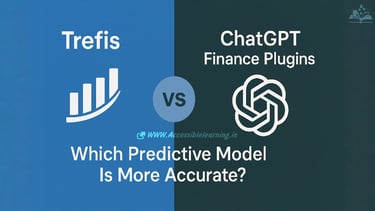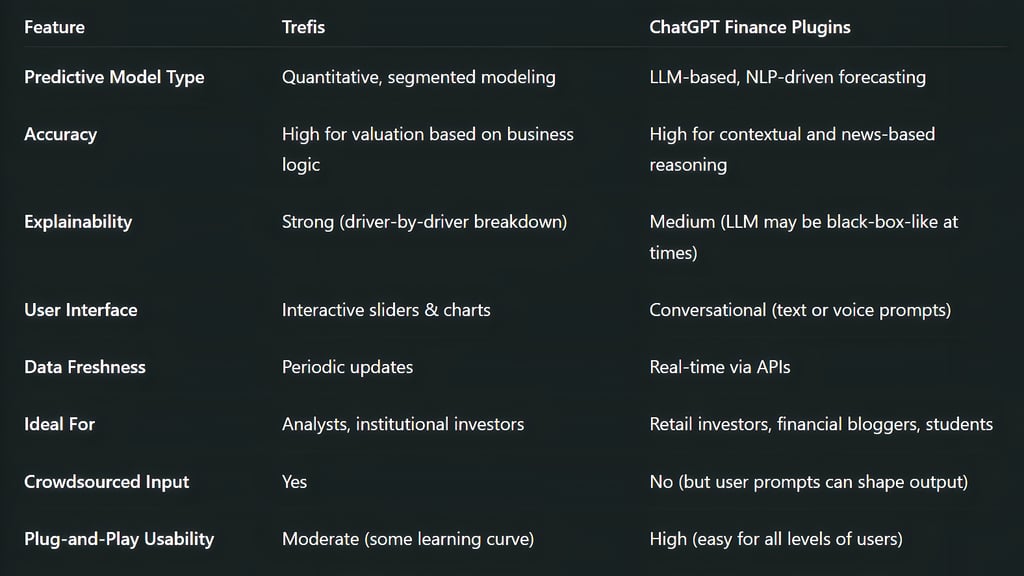
Trefis vs ChatGPT Finance Plugins: Which Predictive Model Is More Accurate for Financial Forecasting?
Compare Trefis and ChatGPT Finance Plugins in depth. Learn which model offers better financial forecasting, predictive accuracy, AI integration, and user trust—perfect for investors, analysts, and finance tech enthusiasts.
AI/FUTURECOMPANY/INDUSTRYAI ASSISTANT
Sachin K Chaurasiya
7/3/20255 min read


In a world driven by data and AI, financial forecasting is no longer confined to spreadsheets and gut instincts. Tools like Trefis and ChatGPT Finance Plugins now offer data-backed predictions and explainable insights in real time. But which one truly delivers the most accurate financial model? This article explores both platforms, their predictive approaches, strengths, weaknesses, and suitability for different user groups.
What is Trefis?
Trefis is a financial modeling platform developed by Insight Guru, aimed at providing interactive, transparent valuation models for publicly traded companies. It uses a bottom-up, segmented forecasting methodology—breaking down a company into individual business drivers like product sales, pricing, or customer growth.
Key Features
Detailed business driver models for over 1,000 public companies.
Interactive charts and sliders for revenue, margin, growth, and valuation forecasts.
Crowdsourced forecasts blended with expert analyst models.
Integrated with Forbes and other financial media.
Predictive Model Approach
Trefis combines historical fundamentals, market data, and analyst insight using a dynamic modeling engine. The platform emphasizes explainable AI—showing users why a company’s valuation changes with specific variables.
What are ChatGPT Finance Plugins?
ChatGPT Finance Plugins—especially tools like Market Data, FinGPT, Koyfin, and Ticker-based Plugins—are AI-enhanced extensions built on OpenAI’s ChatGPT. They provide natural language interfaces for accessing live financial data, portfolio analysis, and forecast insights.
Key Features
AI-powered conversational finance insights.
Access to real-time data feeds (via APIs like Alpha Vantage, Yahoo Finance, etc.).
Contextual forecasting based on company news, earnings reports, and global economic events.
Integration with LLMs (Large Language Models) for reasoning-based predictions.
Predictive Model Approach
ChatGPT Plugins utilize LLM-based reasoning, statistical regression, and pattern recognition to forecast prices or trends. Though not strictly quantitative in the same sense as Trefis, they excel in narrative-driven scenario analysis.


Predictive Accuracy: Who Wins?
Accuracy in financial forecasting is multifaceted. Let’s look at how each platform performs based on use cases:
Trefis Accuracy Highlights
Uses firm-specific variables for valuation.
Transparent logic boosts model integrity.
Empirical backtesting shows strong alignment with historical stock performance.
Best for mid-to-long-term valuation rather than short-term movements.
ChatGPT Finance Plugins Accuracy Highlights:
LLMs shine in event-based predictions (e.g., market reactions to earnings).
Capable of multi-source synthesis: combines news, data, and sentiment.
Performs well in volatile markets, though less rigid than quant models.
Real-time adaptability is its superpower.
👉 Verdict:
For structural valuation (fair value, DCF-based models) → Trefis wins.
For reactive, contextual forecasting (news impact, AI sentiment) → ChatGPT Plugins lead.
Use Case Scenarios: Choosing the Right Tool
For Financial Analysts
Use Trefis when conducting in-depth valuation reports, calculating intrinsic value, or preparing investment memos.
For Active Traders
Use ChatGPT Finance Plugins to monitor earnings calls, track market sentiment, and query news-driven stock volatility in real time.
For Students & Educators
ChatGPT Finance Plugins offer a learning-friendly interface and encourage financial literacy through conversation.
For Institutional Investors
Trefis supports detailed data audits, forecasts, and regulatory-grade modeling useful for high-stakes investment decisions.

Underlying Model Architectures
Trefis Technical Foundation
Deterministic Modeling Engine
Trefis uses a rule-based deterministic approach, where business components are modeled as modular nodes with dependencies. These nodes are interlinked through financial equations, often akin to factor graphs.Discrete Variable Simulation
Users can manipulate variables like ASP (average selling price), shipment volume, or margins to see the effect on earnings and valuation. This is powered by multivariable regression models combined with Monte Carlo simulations to assess potential valuation ranges.Dependency Resolution Logic
The engine prioritizes causal modeling, applying precedence graphs to understand how one change (e.g., pricing) cascades through margins, revenue, and EPS (earnings per share).
ChatGPT Finance Plugins (with LLM Integration)
Transformer-Based Architecture
Built on GPT-4 architecture, these plugins utilize attention mechanisms to identify latent financial signals, correlations, and event-driven dependencies.Hybrid Retrieval-Augmented Generation (RAG)
Plugins like FinGPT, Koyfin, or Marketstack fetch structured and unstructured data via APIs, which are then embedded and processed through vector search to generate context-aware insights.Dynamic Prompt Engineering
The financial plugins use dynamic system prompts to steer the LLM output depending on user input, often including metadata like ticker symbol, time range, and market sector.
Data Sources & Resolution
Trefis Data Pipeline
Structured Data Only
Sources include SEC filings, 10-K/10-Q, company press releases, and proprietary market models.Temporal Granularity
Typically quarterly or annual, with deep support for historical time-series decomposition.Data Normalization
Values are sanitized through GAAP-compliant adjustments and industry-standard accounting treatments (e.g., segment margin smoothing).
ChatGPT Plugin Data Pipeline
Multimodal, Multisource Input
Integrates real-time market feeds, news sentiment, social media signals, and macroeconomic data.Temporal Granularity
Near real-time updates (e.g., intraday movements, options volatility).Data Fusion & Tokenization
Uses embedding tokenizers to fuse price signals with narrative content, allowing NLP models to identify implicit investor sentiment.
Forecasting Techniques & Enhancements
Trefis Enhancements
Scenario Analysis Framework
Embedded tools for best-case, base-case, and worst-case scenarios.Sensitivity Heatmaps
Matrix visualizations showing elasticity of valuation to different input drivers.Comparative Sector Analysis
Aligns a firm’s forecast with industry peer benchmarks, often using clustered comparative ratios (like EV/EBITDA).
ChatGPT Plugin Forecasting Enhancements
Zero-shot and Few-shot Learning
Capable of forecasting with little to no prior examples for unseen financial questions.Event-Driven Forecast Adjustments
Uses named entity recognition (NER) and temporal tagging to react to earnings reports, product launches, or geopolitical events.Sentiment-to-Price Mapping
Maps qualitative sentiment to quantitative stock price outcomes using finBERT, LlamaIndex, or OpenBB APIs when embedded in plugin chains.
Accuracy Metrics & Evaluation
Trefis Evaluation Metrics
MAPE (Mean Absolute Percentage Error)
Used to validate model forecast precision against real-world historicals.R-Squared for Driver Regression Fit
High R² values indicate a strong correlation between modeled drivers and company KPIs.Backtesting
Trefis models are regularly backtested using rolling window analysis over prior fiscal years.
ChatGPT Plugin Evaluation Metrics
Confidence Scoring (LLM Output)
Some plugins score answers using token probability metrics to suggest reliability.Bayesian Updating
In certain advanced plugins, Bayesian priors are applied to adjust forecast ranges as new data arrives.Sentiment Consistency Check
NLP confidence intervals and standard deviation from historical sentiment help flag potential misinformation or outlier outputs.
Security & Compliance Considerations
Trefis
Adheres to SOX (Sarbanes–Oxley) compliance in terms of data integrity.
Models are transparent and audit-ready, making them usable in compliance-sensitive environments (e.g., portfolio management, banking).
ChatGPT Finance Plugins
Plugins operate under OpenAI’s plugin sandboxing architecture, meaning:
Data doesn’t persist unless specifically stored.
Access to financial APIs is controlled through OAuth2.0 or API keys.
Disclaimers and bias filters are used to ensure outputs are non-advisory and general in nature, limiting liability.


Which Predictive Model is More Accurate?
The answer depends on your intent and timeline:
Trefis offers quantitative clarity and is trusted for valuation modeling.
ChatGPT Finance Plugins provide contextual intelligence and thrive in real-time adaptive forecasting.
If you're building long-term models or comparing intrinsic company worth, Trefis remains more accurate and explainable.
If you’re reacting to market dynamics or synthesizing complex global signals, ChatGPT Finance Plugins deliver broader, timely, and intelligent insights.
Both Trefis and ChatGPT Finance Plugins represent the frontier of predictive finance—one grounded in structured fundamentals, the other powered by language and learning. In the age of AI-finance convergence, the most effective strategy might be a hybrid one: using Trefis for logic and ChatGPT for language to unlock complete financial foresight.
FAQs
What is the main difference between Trefis and ChatGPT Finance Plugins?
Trefis uses segmented, fundamental-based financial models to predict company valuations, while ChatGPT Finance Plugins leverage large language models and real-time data APIs for contextual, event-driven financial analysis.
Which platform offers more accurate long-term forecasts?
Trefis typically provides more accurate long-term forecasts due to its structured valuation models and company-specific business drivers.
Can ChatGPT Finance Plugins be used for real-time trading insights?
Yes. ChatGPT Finance Plugins are ideal for short-term and real-time insights, especially when reacting to news, earnings releases, or macroeconomic events.
Are these platforms suitable for beginners in finance?
ChatGPT Finance Plugins are more beginner-friendly due to their conversational interface. Trefis, on the other hand, may require a basic understanding of financial modeling.
Do Trefis and ChatGPT plugins use AI for predictions?
Yes. Trefis uses deterministic, logic-based AI models for fundamental forecasting, while ChatGPT Plugins use LLMs (like GPT-4) for contextual reasoning and pattern recognition.
Is there a hybrid way to use both Trefis and ChatGPT Finance Plugins?
Absolutely. Many investors use Trefis for base valuations and ChatGPT Plugins for event-driven, adaptive market interpretation, creating a well-rounded analysis workflow.
Subscribe To Our Newsletter
All © Copyright reserved by Accessible-Learning Hub
| Terms & Conditions
Knowledge is power. Learn with Us. 📚


